

See Tageo.com database with link to Google Maps.
Schwanfeld is a rural town of approximately 83k people located in the area once called Lower Franconia (Unterfranken) in Bavaria, in the district of Schweinfurt, about midway between the town of Schweinfurt and the city of Würzburg.
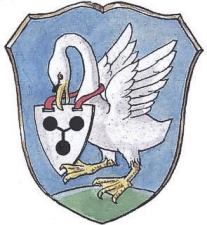
Schwanfeld Town Shield
from Bayerns Gemeinden.
Site and image cited with kind permission from the Centre of Bavarian History, Eva Brockhoff, M.A., Dept. Head
Schwanfeld's Jewish History
Jewish presence in Schwanfeld goes back to the Middle Ages and the town itself is mentioned in documents recounting the 1298 Rindfleisch massacres in which around 100,000 Jews were murdered. The 16th Century saw a considerable Jewish settlement there, with the cemetery inaugurated in 1579, along with an active Jewish school, court system, and rabbi. Beginning the following year, the Schwanfeld Jewish community was obliged to pay an annual tribute of 12 guldens. A Mr. Hirsch is mentioned in a 1622 document, as a farmer and horse dealer and the owner of two houses.
The Schwanfeld cemetery also served as burial ground for Jews from the nearby communities of Bibergau, Dettelbach, Estenfeld, Gochsheim, Untereisenheim, Theilheim, Rimpar, and Schwebheim. A Chevra Kadisha was established, probably in 1712, according to a date chiseled on a stone basin in the tahara house. Schwanfeld's synagogue was built in 1786.
The Jewish population of Schwanfeld peaked in the 19th Century, numbering 230 in 1816 (possibly a third of the total population). A Gemillus Chassadim (charitable organization) was founded in 1821, and in the same year an organization for the promotion of Jewish arts and crafts. That same century saw pogroms, as attested by this article from the May 23, 1866 issue of the local newspaper “Der Israelit.”

Image from Alemannia-Judaica, with kind permission of Dr. Joachim Hahn
Freely translated, the piece reads, “Schweinfurt. The daily, ‘Schweinfurter Tagblatt,’ reports that a Jewish neighborhood of Schwanfeld was attacked by a mob, which carried out various acts of aggression against the people living there, breaking house windows and chasing down and roughing up Jews."
The shochet of Schwanfeld was also expected to act as religious teacher and prayer leader, as shown in this announcement, posted in “Der Israelit” on December 23, 1909:
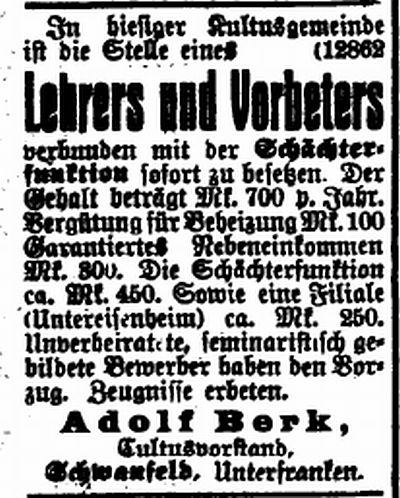
Image from Alemannia-Judaica, with kind permission of Dr. Joachim Hahn
Free translation: "The local [Jewish] Community seeks to fill immediately the position of teacher and prayer leader, to serve in conjunction with that of shochet. Salary is 700 marks a year, with a heating charge of 100 marks. Guaranteed supplementary income of 300 marks. Salary for shochet is approximately 450 marks, with 450 additional marks for serving in Untereisenheim. Preference given to unmarried applicants, seminary educated. Certificate required. [Contact] Adolf Berk, Community Director, Schwanfeld, Lower Franconia."
Schwanfelders were also patriots and served in WW I. Here is a monument that includes the names of three fallen Jewish soldiers, Jakob and Richard Berk and Louis Stern.
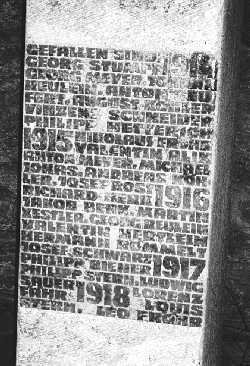
Photo from Für das Vaterland starben/They died for their Fatherland
Reproduced with kind permission from Eva Brockhoff of the Haus der Bayerischen Geschichte
By 1924, with a total of 81 Jewish inhabitants, there was a private school for 10 Jewish children, as well as a mikveh. Community leaders included Josef Frankenthal and Max Blättner, while Siegbert Friedemann served as teacher, prayer leader, and shochet. The Chevra Kadisha was still functional, directed by David Blättner, with 14 members, as was the Chevra Gemillus Chassadim, led by Emanuel Gutmann up until 1932, with 10 members. A Bikkur Cholim (health assistance organization) was headed by Josef Frankenthal.
In 1931-33 there were still about 58 Jews in Schwanfeld, while community organizations continued to function, co-led by Julius Gutmann and Ferdinand Bamberger: the Chevra Kadisha, a Women’s Organization, led by Mrs. L. Blättner, with 15 members, and a religious school headed by interim teacher and cantor Martin Selmanson, who instructed five children in religion in the 1931-32 school year.
With National Socialism came the ransacking of the synagogue on Kristallnacht in 1938, ending its life as a house of worship. The community continued to dissolve, due to increased repression and deprivation of rights, with the bulk of the population emigrating, the majority to the USA, followed by England, Palestine, and other German areas. In 1942, eight of the remaining ten Jews were rounded up and sent to Würzburg, where they were shipped off to the Izbica "holding camp." The remaining two Jews were sent to Theresienstadt. Community leaders Max Blättner and Julius Gutmann were among the victims, Mr. Blättner perishing in Riga in 1942, and Mr. Gutmann somewhere in Poland, according to YadVashem.
The most illustrious Schwanfelder, but one whose life is emblematic of the destruction of the Schwanfeld Jewish community, was Dr. Ludwig Frankenthal. Born in Schwanfeld on 27 November, 1885, the first of the ten children of Josef and Clothilde Veilchenblau, Ludwig studied medicine at Munich and Berlin, becoming a specialist in kidney injuries and kidney tumors. He was invited to Leipzig, where he became one of the medical directors of the Israelitsichen Krankhaus Leipzig. He excelled in both personal treatment and in research, publishing 50 medical papers by 1937. While in his workplace he was arrested by the Gestapo, the day after Kristallnacht, and ordered to leave the country with his wife, Ilse, an artist, and their two young sons. The family attempted to get visas to travel to the US, but ended up in Holland, where three of Ludwig’s brothers were living. Forced to practice medicine in a Dutch concentration camp, Ludwig disobeyed an order to sterilize 13 women, knowing that the penalty would be the gas chamber. Transported soon to Terezin, the family's ultimate destination was Auschwitz, where Ludwig and their younger son, Wolfgang, were immediately murdered, on October 14, 1944. The elder son, Günther, died shortly after liberation. Ilse survived five concentration camps and lived out her life in Brunnsum, Holland, lending her name to an organization for the arts, the Ilse Frankenthal Stichting, whose spirit is based on Ilse’s motto, “Don’t bring art to the people; bring the people to art.” Of the ten children of Josef and Clothilde Frankenthal, eight perished in the Shoah.
Much of the information about this family is based on an article by Dr. Andrea Lorz, translated by Peter Held and appearing in the Spring, 2006 Issue, Number 201, of the Jewish Quarterly. Grateful thanks to JQ editor Rachel Lasserson for permission to reproduce material from this article.
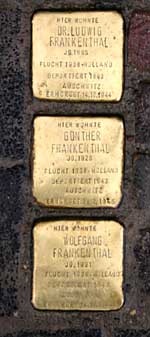
Memorial brass paving stones (Stolpersteine) placed for public viewing at the Frankenthal family residence at No. 13 Dittrichring Street in Leipzig, part of artist Gunter Demnig's Stolpersteine Project, reproduced in Leipziger Internet Zeitung. The stones were donated by Professor Eberhard Ulm, his colleagues and his students, of the Henriette-Goldschmidt School of Leipzig. This school was founded by Henri Hinrichsen, father-in-law of Dr. Ludwig Frankenthal, and himself a Shoah victim.
Today all that remains of Jewish life in Schwanfeld is its dead and a few monuments. The Jewish cemetery is currently without a caretaker familiar with the gravestones, which are in drastic need of documenting and preserving. Many of them are so worn as to be unreadable. Two references to the cemetery can be found in JewishGen's International Cemetery Project. The two-story tahara house still stands and still contains the stone washing table and basin. The building that housed the synagogue still stands, used today as a private residence, and located at No. 17 Wipfelder Street. The last person buried in the Schwanfeld Jewish cemetery was Miriam Schwab of Rimpar, who died on January 22, 1939. With the death, in 1984, of the last Jew born in Schwanfeld, the road leading to the cemetery has been named in his honor and to commemorate the disappeared Jewish community, "Ludwig-Gutmann-Weg."* Visitors are evidently welcome in Schwanfeld, as declared by its mayor in the website below.
*Use "Zoomstufe" to 13+ setting
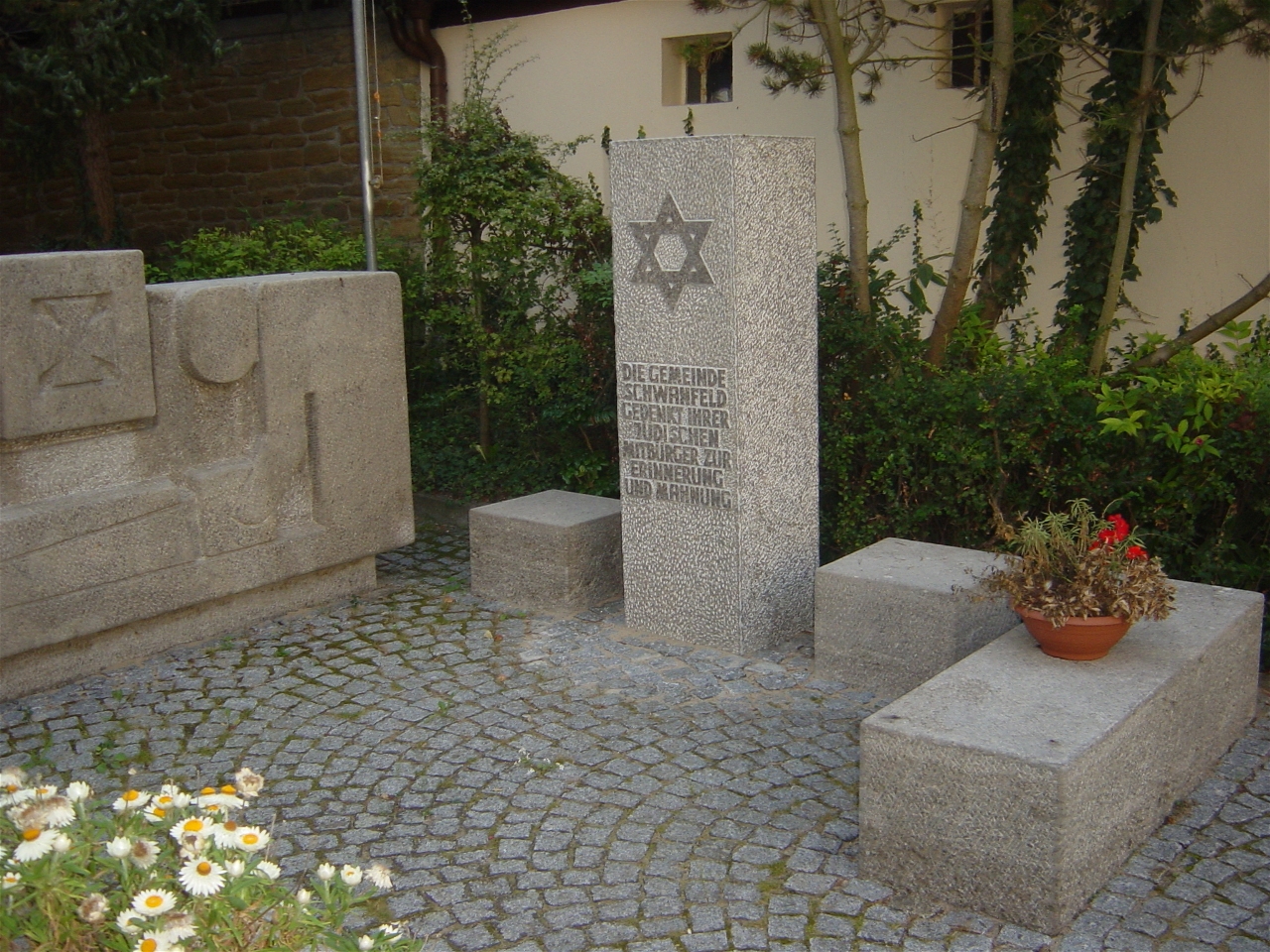
Memorial to the Jewish families of Schwanfeld, erected in 2005, and funded by the people of Schwanfeld at the behest of mayor Hans-Georg Eichelbrönner
The inscription reads "Die
Gemeinde Schwanfeld gedenkt ihrer ehemaligen jüdischen Mitbürger - Zur
Erinnerung und Mahnung" (The community of Schwanfeld remembers its former Jewish
townspeople - In memoriam).
About Yizkor (Memorial) Books - From the New York Public Library
Alemannia Judaica - Jewish history of southern Germany . Linked with the kind permission of Dr. Joachim Hahn
The Ephraim Gustav Hoenlein Genealogy Project : Source of German-Jewish genealogy
"Gelieben sind die Namen" - 1996 film about Schwanfeld's Jews, by Dietmar & Olaf Schrader.
History of the Schwanfeld Synagogue & Jewish Community: From Alemannia- Judaica
JewishGen Family Finder (JGFF): Find other researchers looking for your surnames and/or towns
Jewish Virtual Library - Linked through the courtesy of Dr. Mitchell G. Bard
Jüdische Gemeinden in Bayern - Jewish life in Bavaria, from 1870 to the present
Landesverband der Israelitischen Kultusgemeinden in Bayern (Organization of the Jewish Community of Bavaria)
rijo research - History-making creation of Susanne Rieger and Gerhard Jochem
Schwanfeld: - Article from Wikipedia (in German)
Schwanfelder Shoah victims, from Yad Vashem
Schwanfeld's Jewish Cemetery is part of the International Jewish Cemetery Project
Shalom Europa - Site of the Jewish Community of Würzburg and Unterfranken
Unterfranken (Lower Franconia) : Articles on neighboring Jewish communities from Wikipedia
Würzburg Stadtarchiv: Contains the bulk of Schwanfeld Jewish records (Juedische Standesregister )
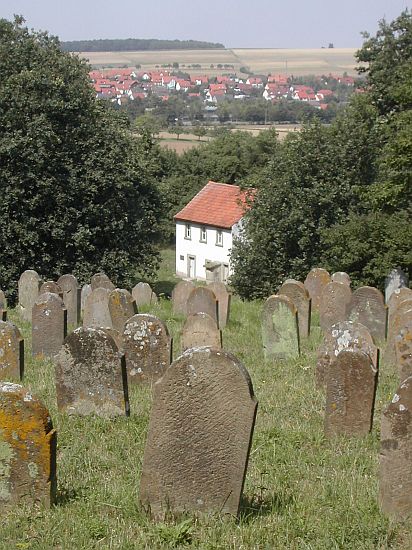
View of Schwanfeld from the cemetery, showing the Taharahaus.
Photo by Klaus Kurre, reproduced with his kind permission.
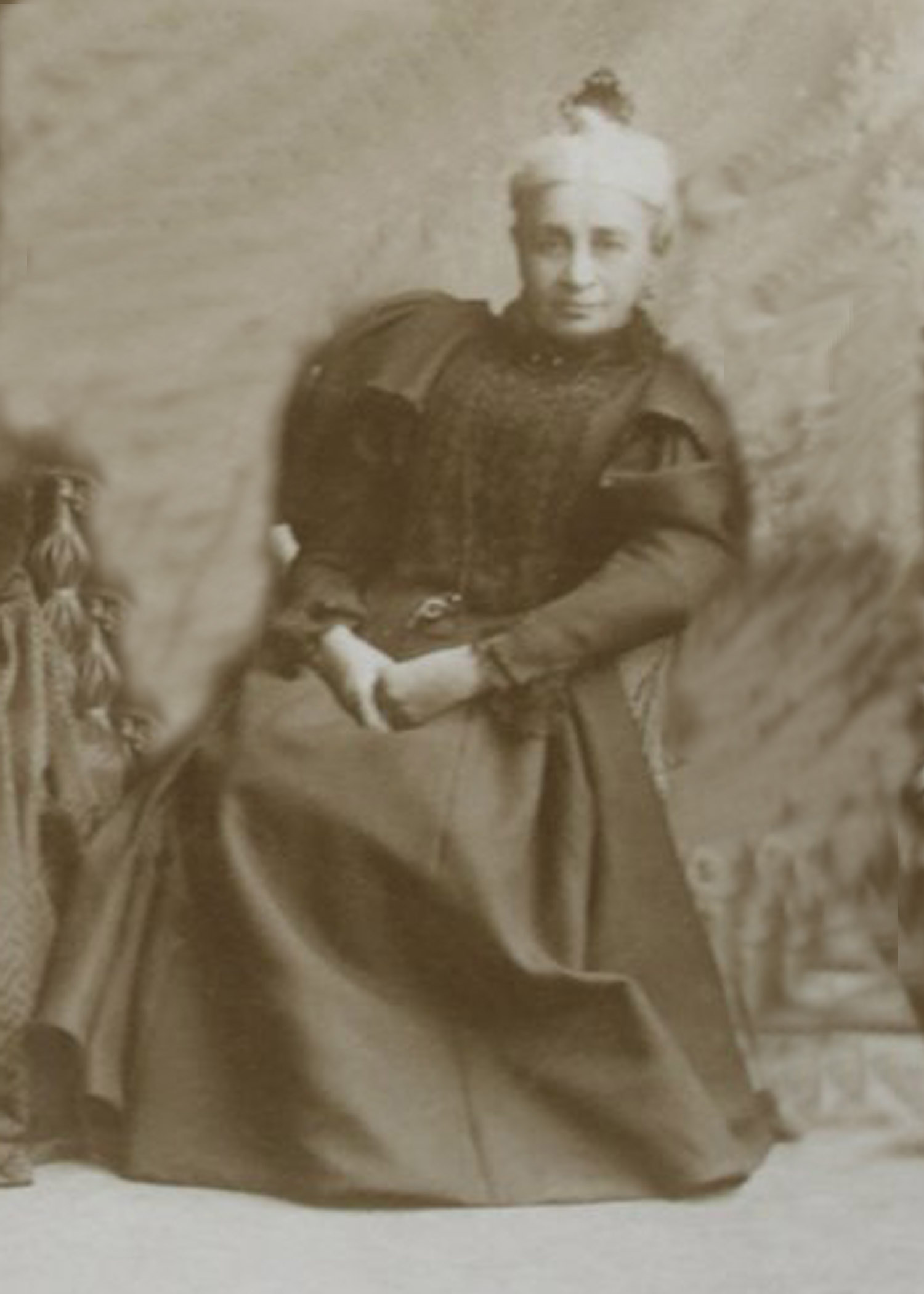
My great-grandmother, Regina Schmalbach Gattmann, daughter of Markus Marum and Esther (Ernestine) Gutmann Schmalbach, born on August 2, 1826, in house number 85, Schwanfeld, died on June 12, 1901, 4829 Vincennes Avenue, Chicago Illinois, buried in Mount Mayriv Cemetery, Chicago, Illinois. Photo courtesy of Tom and Betty Philipsborn.
Regina's grave. Photo by Judith Berlowitz
Acknowledgments: Thanks to the patient Barbara Ellman and Susana Leistner-Bloch of JewishGen, Schwanfeld Mayor Hans-Georg Eichelbrönner and cemetery caretaker Gerhard Hempel, webmaven Theresa Roeder, Eva Brockhoff, Dr. Joachim Hahn, Dr. Mitchell G. Bard, Klaus Kurre, Bonnie Zeisler Frederics, Jerry Zeisler, and Yaron Zakay, and to the blessed memory of my Schwanfeldere Vorfähren.
|
Updated by jb, 16 February, 2008 Copyright © 2007 Judith Berlowitz |
This site is hosted at no cost by JewishGen, Inc., the Home of Jewish Genealogy. If you have been aided in your research by this site and wish to further our mission of preserving our history for future generations, your JewishGen-erosity is greatly appreciated.